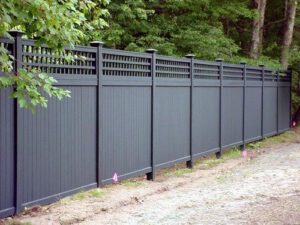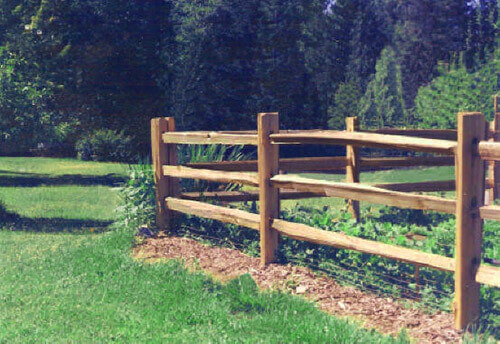No more nosy neighbors or feeling self-conscious in your backyard pool—privacy fencing is a great way to feel at home on your property.
Before you start planning your fence, contact Gastonia Fence to have utility lines marked. This will prevent expensive and potentially dangerous mistakes during the fence installation process.

Privacy fences block the view of your home and yard from neighbors neighbors’ homes and passersby on the street. They also keep you and your guests protected from trespassers on your property. They are an excellent choice for suburban and urban areas where houses sit close together.
Many homeowners choose horizontal wood slats for their custom fences to provide a modern, contemporary style and maximum privacy. This style of fencing pairs well with current homes and is available in a wide variety of materials, from Western red cedar to treated pine. You can customize your horizontal privacy fence with various optional custom options, such as steel posts, shadow boxes, and lattice top rails.
Another option is a vinyl privacy fence in various styles and colors. It’s an excellent choice for those who want a low-maintenance fence, as it does not need to be painted. However, it may not be as durable as a wood or metal privacy fence.
Before building your privacy fence, check with your homeowner’s association or local county offices for details on what style, height, and fence material are permitted in your community. You want to avoid the hassle of building a six-foot wood privacy fence only to find out you must have it lower due to zoning regulations.
It’s also good to talk with neighbors about your plans for a privacy fence. This will ensure everyone is on the same page and create a smoother installation process. It will also help keep good neighbor relationships intact.
A privacy fence can add to the value of your home, which can be an asset if you ever decide to sell it. It can also increase your curb appeal, which can help you achieve a better sale price and make your home more appealing to potential buyers.
A privacy fence can protect you from nosy neighbors and give you peace of mind when your children or pets play in the backyard pool. You can relax and enjoy the outdoors without worrying about your neighbors watching you. Adding a privacy fence can also help prevent break-ins because criminals are less likely to scan a property for valuables when they cannot see the house or yard.
Besides providing privacy and aesthetics, security fences offer protection from intruders. High-security fencing uses a variety of materials and designs to ensure safety on a property. Steel is a popular choice for homeowners looking for a modern look while providing security. Its thick, solid design makes it difficult for intruders to break into or cut through, giving property owners peace of mind.
The first thing to consider when installing a security fence is your goals. Do you want to keep children and pets safe while playing outside? Do you want to block out noise from neighbors? If you don’t know how to answer these questions, start by doing your research. Check with local zoning or building offices to see what fences are allowed and how tall they can be. You should also check with your homeowner’s association to ensure you don’t have any restrictions on the style or height of your fence.
Once you have a clear idea of what you’re looking for, start by thinking about your budget and how much maintenance you’re willing to do. Remember that the upfront cost of a privacy fence is typically higher than that of a screen, but it’s worth the investment for the increased security and peace of mind it offers your family. The right fence material can also save you money in the long run, as some are resistant to warping, rot, and insects.
In addition to wood and vinyl, metal security fences are a great option for those who prefer a more industrial look. These metal fences use tightly woven steel wires to create an impenetrable barrier and allow homeowners to control visibility. These fences are a good choice for businesses that value privacy, such as data centers, because they protect against physical and cyber espionage.
Planting a living fence is another way to add security and privacy to your backyard. Using hearty shrubs, bushes, and trees to form a wall around your outdoor space looks beautiful and can help protect you from intruders who might try to enter the area. This is especially important for families with children or pets who love to spend time outdoors.
A beautiful fence enhances your property’s curb appeal, a crucial factor in how potential homebuyers perceive your home. Like cuffs and earrings to a suit, fences are the finishing touch on your home’s appearance – without one, people will feel that something is missing.
A fence can add a wow factor to your home, and when maintained properly, it can keep that beautiful appearance for years. But it’s important to stain the wood regularly so it doesn’t develop a grey patina over time.
Wooden privacy fences come in various styles and designs, so it’s easy to find a design that suits your home’s exterior. We recommend that you choose a style that looks cohesive with your overall front yard and house design so that when viewed from the street, your entire property appears as a single, harmonious vision. For example, a traditional vertical board-on-board fence might look best if you have a rustic farmhouse. Or, if your house is contemporary, a sleek horizontal slat fence may be more appropriate.
A privacy fence is a great investment for your home. It protects your family from prying eyes and increases the value of your property. It also provides a safe and secure environment to enjoy the outdoors. However, like any home improvement project, a fence requires maintenance to last. The type of maintenance needed depends on the type of fence you choose.
Wooden fences require routine cleaning to prevent mold and rot. They also need to be stained or painted every few years. Vinyl and composite fences are low-maintenance options that don’t require painting or staining.
To keep your fence looking good and in its best condition, it’s important to choose a high-quality material. Look for materials with durable finishes and a long warranty. This will help ensure that your privacy fence looks good for a long time.
Some homeowners create their natural privacy fence by planting trees and shrubs. Cypresses, red cedars, and lilacs are some options that can grow tall enough to block your backyard from your neighbor’s view. If you go this route, it’s a good idea to consult a landscaping professional to ensure your plants will thrive and offer the privacy you desire.
Another way to add natural privacy is by building a wooden fence with wide gaps between slats. This style of fence gives you more flexibility regarding visibility, but it is more sturdy than a solid-panel fencing option.
Using quality materials that will stand the test of time is important if you use a wooden privacy fence. Pressure-treated wood is popular because it is affordable and easy to work with. This type of wood is treated with chemicals that protect it from rot, mold, and other issues.
Consider adding a trellis to add a style to your fence. This can be used to support vining flowers, such as clematis, or to display climbing vines. This can also be a great way to add color to your backyard.
In addition to cleaning your fence, you should check the posts’ condition and ensure they are firmly planted in the ground. A loose post can cause the chain link to become crooked and may not be able to hold up the weight of your property. If you see that a post is loose, it should be replaced immediately. Likewise, if you see that a hinge is damaged, it should be fixed right away. Taking care of these minor problems will ensure that your chain-link fence lasts many years. Regarding security, a chain-link fence is one of the most effective options for residential properties, but you should always consult with local authorities before installing a new fence. Many cities ban chain-link fences for residential homes, while others have strict height restrictions for front and backyard fencing.

